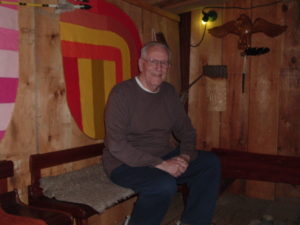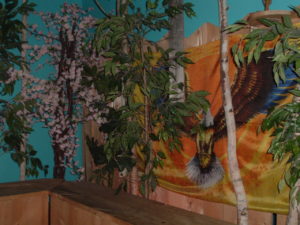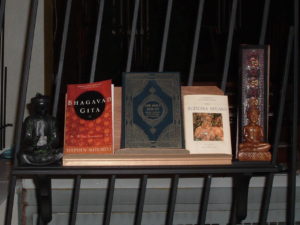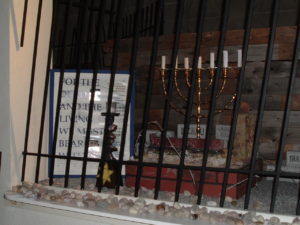 I grew up as a Catholic, but have been practicing other religions and studying spiritual philosophies since my early twenties, notably Buddhism, Yogic philosophy, Hinduism and Native American Spirituality.
I grew up as a Catholic, but have been practicing other religions and studying spiritual philosophies since my early twenties, notably Buddhism, Yogic philosophy, Hinduism and Native American Spirituality.
I’ve always been a seeker of Truth and interested in matters of the Soul/Spirit. What I’ve found with these spiritual explorations is that they all share the same message of love, tolerance, compassion and respect of one another.
There’s a Roman Catholic Church near my place, called Holy Family Parish, who exhibits a sign saying “Respect you neighbor’s religion. To live in Harmony” and shows symbols identifying all religions, including aboriginal spirituality. As a matter of fact, an Inuksuk is nestled at the left side of the steps leading up to its entrance. I’d been curious about going for a while and this summer, I took a leap of faith and went to mass.
The first thing you notice when walking in is how much this church doesn’t look like a traditional church! The ceiling is covered in a “web”, symbolizing the web of life in aboriginal cultures, from which a dream catcher is suspended. In place of a crucifix behind the alter, there’s a massive open armed Jesus, dressed in robes as he would have been in the context of his time. Near this Jesus is a screen, from which audiovisual material is used to support the liturgy of the day.
On the right side, the sacred corner where the Bible rests, you will find the Torah, the Koran, the Baghavad Gita, and Buddhist texts. There’s also a permanent shrine commemorating the Holocaust. The left side shows a mural that says “Respect”, with human shapes on which symbols from various religions are inscribed. A poster at the front left proclaims “Jesus belong to everyone. We are all Brothers and Sisters.” And so on…
“How can this be?” I wondered with amazement. Then, the answer to my question came out to celebrate mass. The answer was to be found in Father John Baxter. He was gracious enough to grant me an interview. It was my pleasure to sit down with this lively, vibrant and clearly passionate man.
Introducing Father John Baxter
 John Baxter was born in Toronto, in 1933, and raised there until 1950, when his family moved to Montreal. At an early age, he felt the vocational call of the priesthood. He always felt drawn to it, inspired by the priest in the parish of his youth. So he followed the natural flow of a “soul calling”, as he says. “You only have one life to live. Why not give it to God?” He also felt compelled to help people spiritually and to be of service to others.
John Baxter was born in Toronto, in 1933, and raised there until 1950, when his family moved to Montreal. At an early age, he felt the vocational call of the priesthood. He always felt drawn to it, inspired by the priest in the parish of his youth. So he followed the natural flow of a “soul calling”, as he says. “You only have one life to live. Why not give it to God?” He also felt compelled to help people spiritually and to be of service to others.
So from 1953 to 1959, he studied the priesthood at Le Grand Séminaire, in Montreal. Father Baxter didn’t speak French (!), yet managed to understand the classes in French and Latin, and was allowed to turn in his schoolwork in English. After being ordained, he was sent to Holy Family Parish to live and assist the Pastor.
He has been there ever since, with the exceptions of one year (1972) spent in London, England to study the New Catechism inspired by Vatican II, and two years at a parish in Pointe-Claire, a city located on the West end of the Island of Montreal.
The shift in the Catholic Church that came with Vatican II, where the concept of “one true church” was put into question, influenced Father Baxter’s style of liturgy. “God is present in all religions and calling all religions to Himself” is a creed that germinated within him, and over time, influenced the interfaith penchant he gradually incorporated into his church.
“Fanaticism is in everyone’s backyard…and turning people off”, he explained. “Some people think that exposure to other religions dilutes their faith. But I believe it can strengthen it by respecting others and knowing that God is working through that too. It’s not about bringing God to people – he’s already there!”, he continued.
His use of audiovisual material is also quite unique, presenting excerpts of documentaries, movies, news reports and television programs during mass. For Father Baxter, the emphasis is to “experience” religion, instead of just absorbing dogma, to make the message of Jesus more relatable. He explains: “In a way, the Eucharist has always been visual and close to entertainment. Bringing media into the building is of our time and visually reinforces the message, makes it believable today. It grounds the Liturgy.”
“How do you see Jesus?” I ask him. “I see him as a brother, a companion, someone who walks with you. My vision of Christ is of one who embraces”. He also contextualizes the Bible, saying “the kernel of God and Jesus are there, but they’re wrapped up in something else.”
One of the last things I ask him about is the aboriginal symbols and spirituality present in the church. I mean, interfaith is one thing, but adding the wise knowledge of Native Americans takes inclusiveness to another level. “Oh, that…” he responds spontaneously, “that’s been there since even before bringing in interfaith!” Father Baxter is very rooted in Nature – or Creation, as he calls it. He’s an outdoors kind of guy.
After the interview was over, he excitedly showed me the “behind-the-scenes” of the church. I excitedly followed him…I always love going beyond where people usually go. “I built (with some help) a morning room and a night room”, he says as we are walking, “Rooms where you can go and relax or have discussions”. He stops in front of an opening, turns the light on. I walk in. The morning room is filled with trees, murals, eagles and other shamanic symbolism. A “fire” is at the center. “Oh my god…this room is amazing!” are words that could not be prevented from coming out of my mouth.
The night room was just as mesmerizing, complete with a wall of glow- in-the-dark little stars, real tree trunks and again, the element of fire. “I have to show you the sweat lodge” was our next venture. He had mentioned it during the interview. You can’t do an actual sweat lodge ritual in it, but it is there to symbolize the purification experienced during this ancient aboriginal tradition. I did one in 2005 and can attest to its power, healing…and intense sweating heat!
To my surprise, the sweat lodge is tucked away inside the church, behind the Wall of Respect. Again, trees (pine trees) hide and define the entrance. A very tall totem and bear (taxidermy) discretely have their place next to it…I had never noticed them before! This little church is full of surprises and infused with Life! Father Baxter’s motto is “Lead by example”. And what an inspiring example he is!
If you want the address to come see for yourself or know more about Holy Family Parish, go to their website at www.aboutholyfamily.blogspot.ca. It’s in the process of being update (like the pictures of the church), but you can still get some information.
I apologize for the quality of the following pictures. The church is dark, my digital camera is archaic and it was hard to figure out the lighting. But if you click on the picture for a bigger view, the visual is clearer.
Peace and Light to all!
Christine was born in Montreal, grew up in the city of Granby, and moved back to Montreal at the age of 19, to start University. Over the course of the years, she’s gotten degrees in Arts & Sciences, Sexology and Journalism, specialized in written press. She also has Certification as a Thai Yoga Massage Therapist.
She’s devoted her career as a sexologist to the cause of HIV-AIDS: Doing sexual education and HIV prevention work with everyone ranging from high school students to inmates to all in between, participating in advocacy efforts for the rights of people living with HIV, supporting them and their families through trying times. In 2002, she took basic Swedish massage training as part of a volunteer program for individuals who wished to offer massages to people living with HIV/AIDS. This volunteer experience changed her life.
Realizing that the truth of people resides in their bodies much more than in their minds, she gradually ended her sexologist career and undertook the study and practice of Thai Yoga Massage. Helping people heal their hearts, souls and emotional wounds through the body, with the power of touch and massage, is at the core of her life now.
The written word and the arts have always been a passion and, after years of being a closeted writer, she’s ventured out into blog land, with We Blog the World. This venue is also an opportunity to explore the visual art form of photography and have people discover Montreal, one of the best cities on this planet, through her unique perspective.












